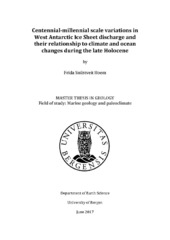| dc.description.abstract | The West Antarctic Ice Sheet (WAIS) may be highly sensitive to future warming and to ocean driven changes in subsurface melting. Understanding this sensitivity is critical as WAIS dynamics are a major source of uncertainty in sea level rise and regional climate projections. Although there is increasing evidence that WAIS discharge has varied on centennial to multi-millennial timescales since the last glacial period, little is known about its most recent (late Holocene) behavior. This period is particularly important as a baseline for delineating natural and anthropogenic driving forces and to understand coupling between climate, ocean circulation, and WAIS discharge. Here we present high-resolution records of WAIS discharge together with co-registered signals of surface and deep ocean physical property changes in a multicore taken from the southern flank of the North Scotia Sea Ridge (53° 31.813 S; 44° 42.143 W at 2750m water depth) spanning the past 4200 years. The site is situated just south-east of the polar front beyond the reach of seasonal sea ice, confining any occurrence of ice-rafted debris (IRD) to iceberg sources, mostly originating from WAIS. The IRD record from core GS08-151- 02MC provides centennially resolved record of iceberg supply from which we infer WAIS dynamics and variability. Oxygen and carbon isotopic composition of benthic (U. peregrina) and planktic (N. pachyderma (s)) foraminifera give (regional) information on past polar deep water and surface water temperatures, circulation and nutrients. The local surface water hydrography appears relatively stable over the past 4200 years with the planktic δ^18O signal indicating centennial-millennial scale changes of typically ≤1°C (Δ0.22‰) and notably smaller in amplitude than the regional warming observed over the past century. The lack of correlation between surface water physical properties and IRD in the downcore records, suggests that IRD does not reflect iceberg survival, but rather changes in the supply (WAIS dynamics) or routing. Consistent with this interpretation, IRD covaries with climate on the Antarctic Peninsula (from James Ross Island ice core) over the past 4200 years with cooler conditions and lower amounts of IRD over much of the past two millennia, and both records indicate a recovery with warming and increased IRD prior to industrialization. This relationship is consistent with the hypothesis that climate and specifically ocean temperatures and circulation were important for modulating the WAIS discharge rates over the past few millennia. | en_US |
